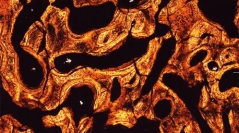

 Comptes Rendus Palevol
10 (5-6) - Pages 439-452
Comptes Rendus Palevol
10 (5-6) - Pages 439-452The parietal frill of Triceratops, one of the largest cranial ornamental features known, undergoes extraordinary morphological changes late in ontogeny — progressing from a large, thickened, solid frill to a substantially larger, thin, fenestrated frill. To understand how this structure changed so dramatically we undertook a histological examination of the caudal end of an ontogenetic series of Triceratops parietals. Investigation revealed a histological progression that involved an initial period of non-pathologic hyperostosis, followed by a phase of external (dorsal and ventral sides of the parietal) resorption and border extension, with a conclusive stage hypothesized to be dense fibrous connective tissues mineralized through the process of metaplasia. These fibrous tissues form the caudal end of the mature parietal as well as the epiparietals that fuse to the caudal border of the frill late in ontogeny. Continued resorption near the central parietal regions of the left and right lateral portions of the parietal eventually results in a pair of large circular fenestrae. This progression is somewhat similar to the parietal ontogeny of Centrosaurus.
Dinosaurs, Histology, Metaplasia, Hyperostosis